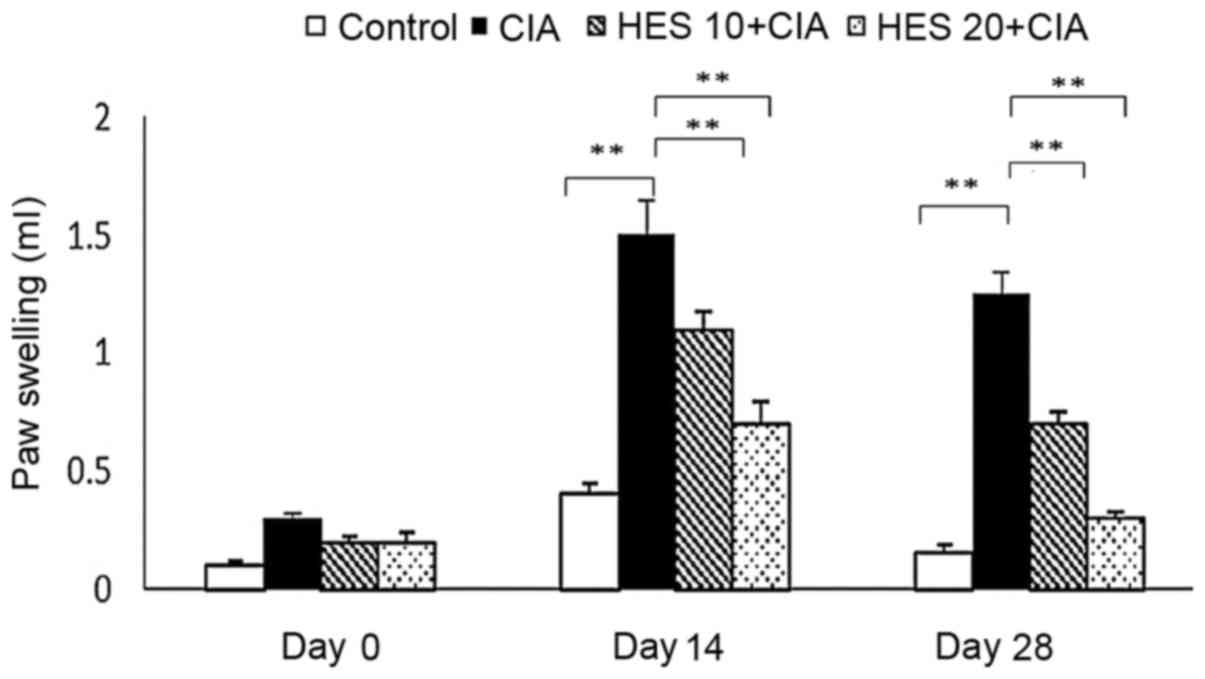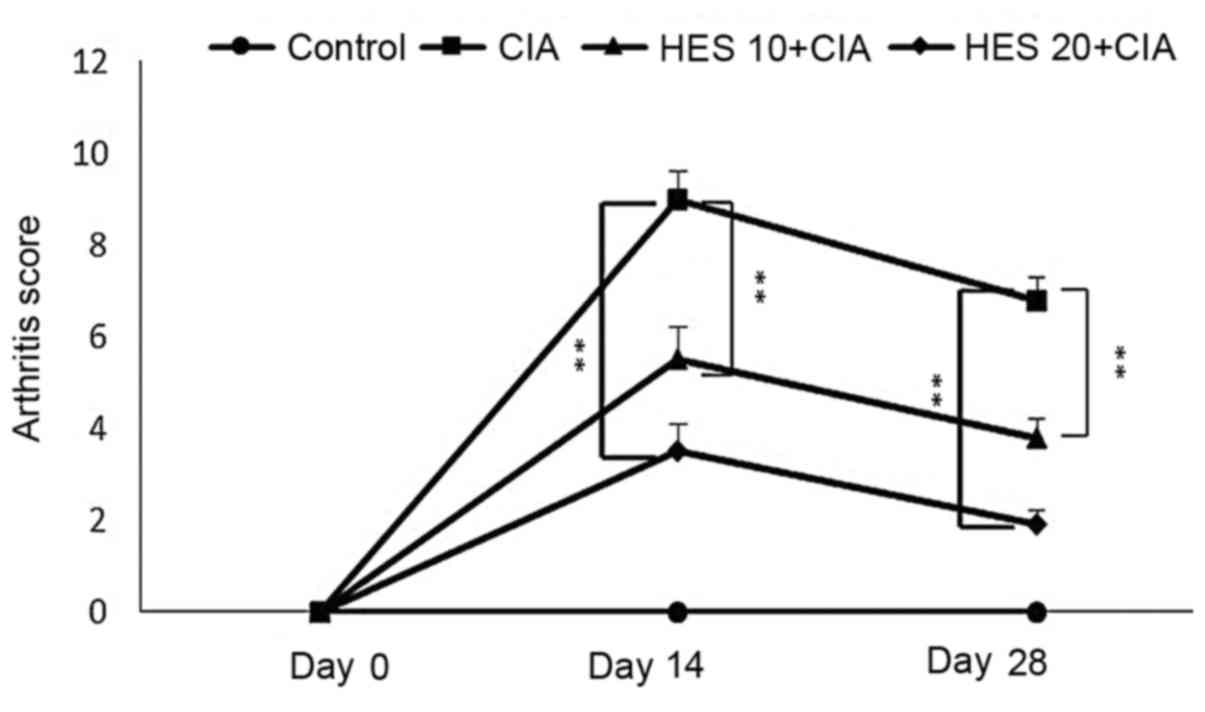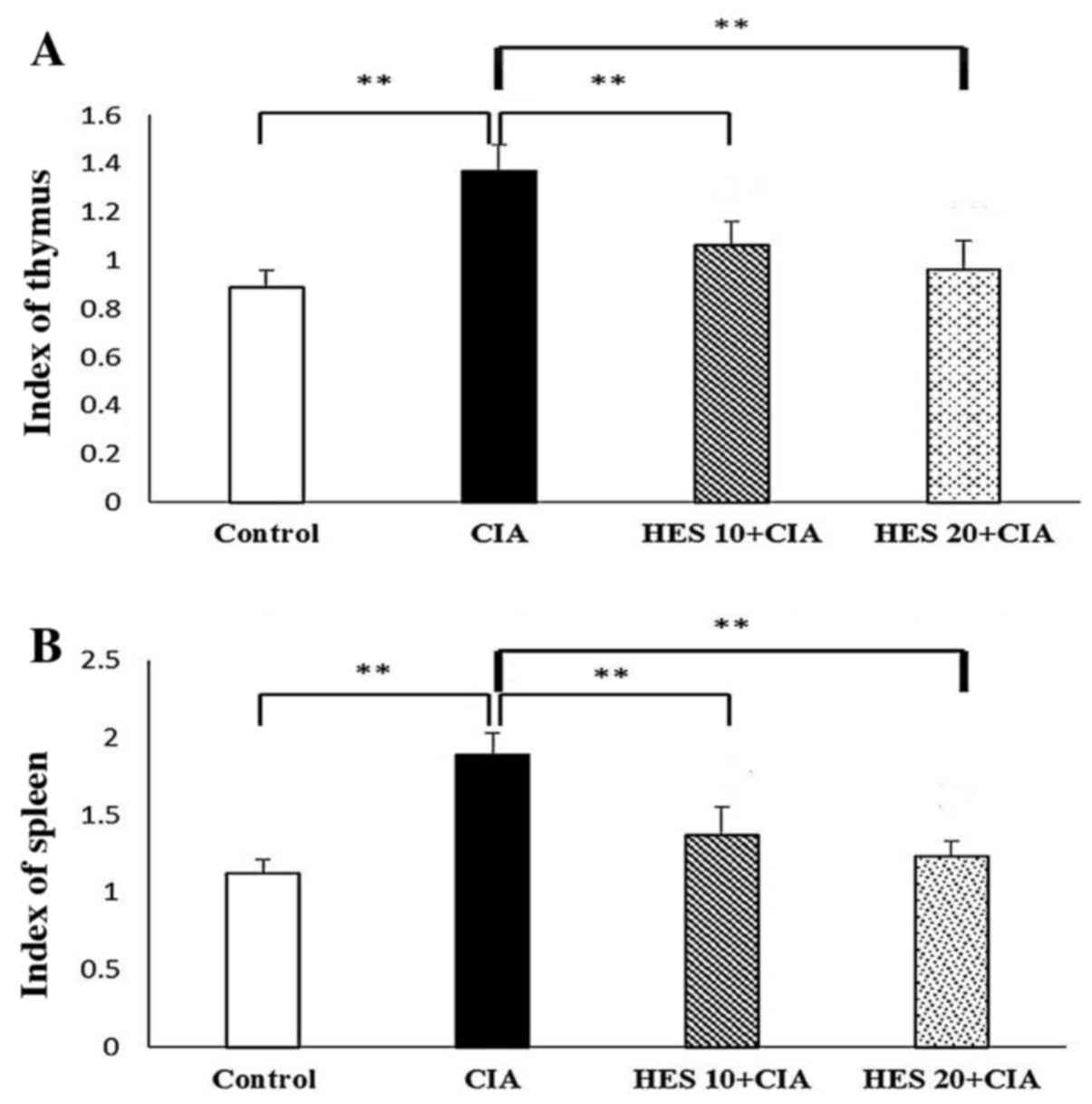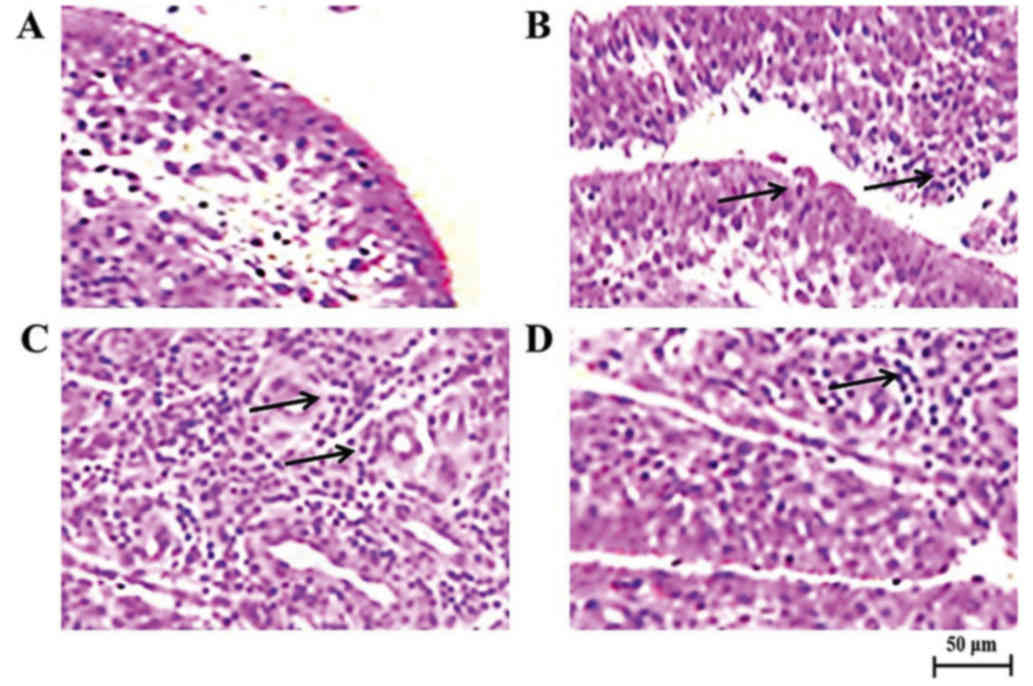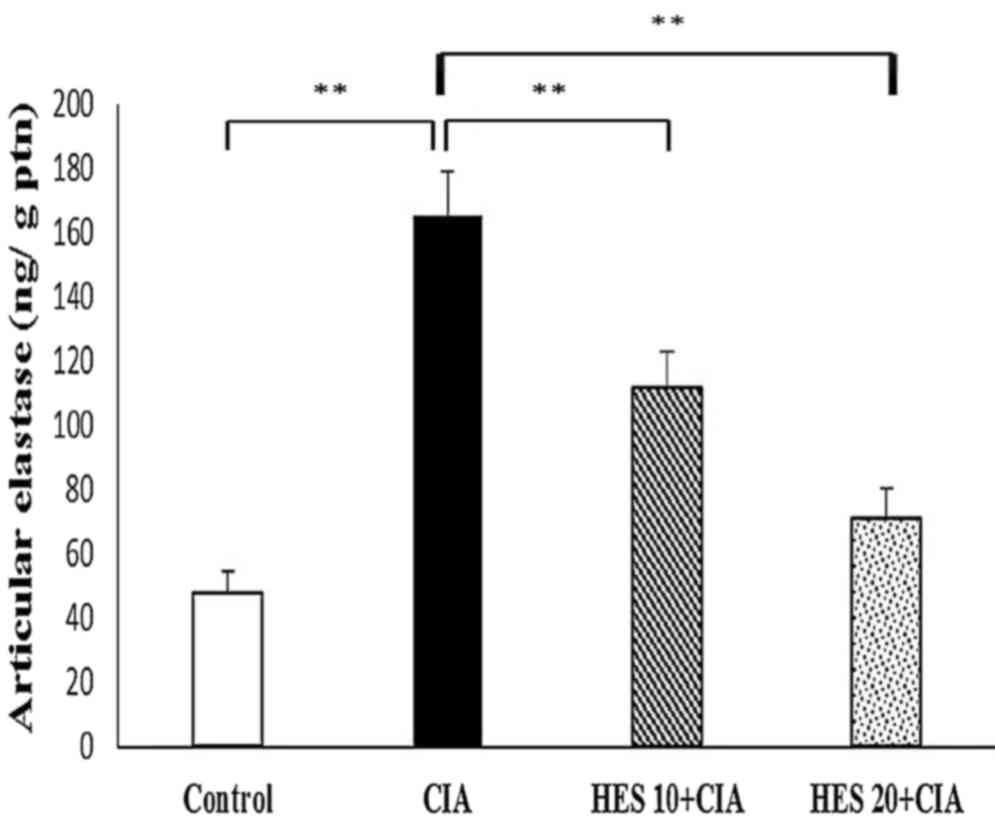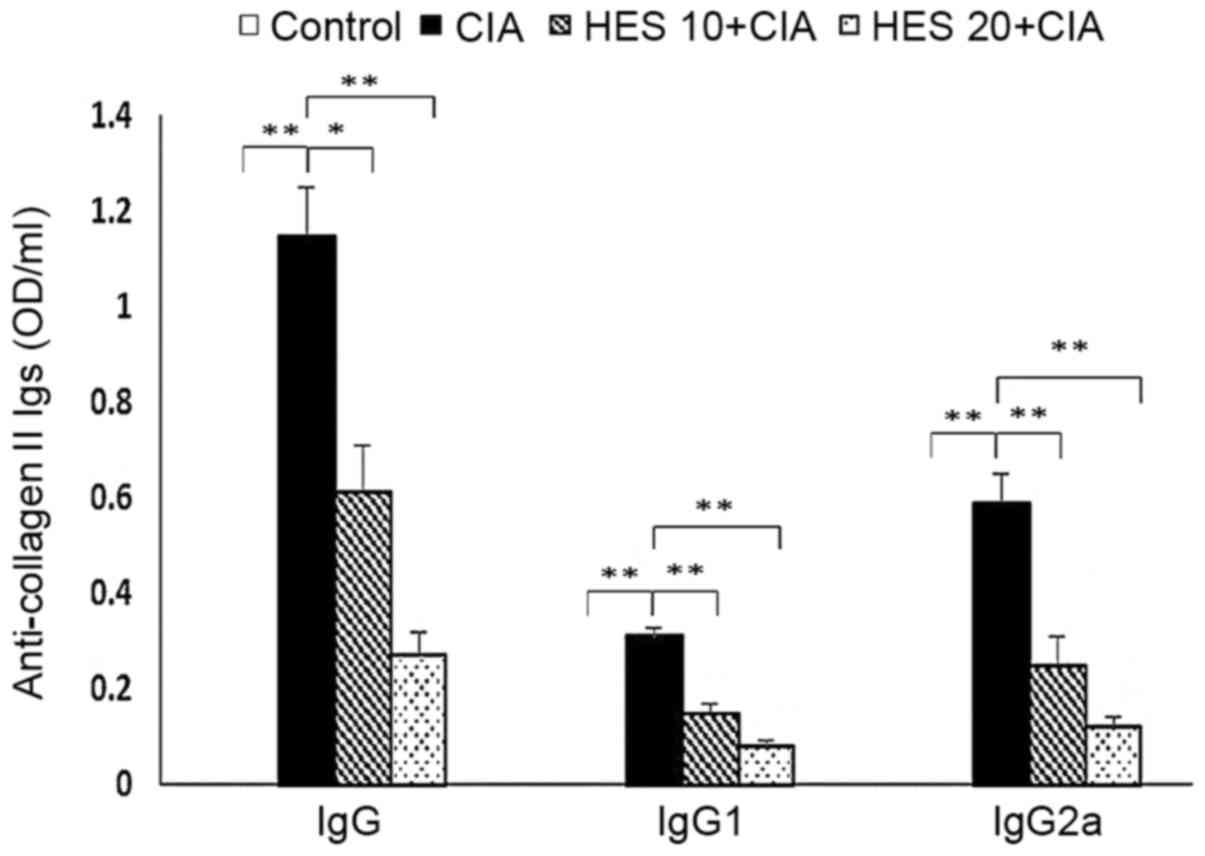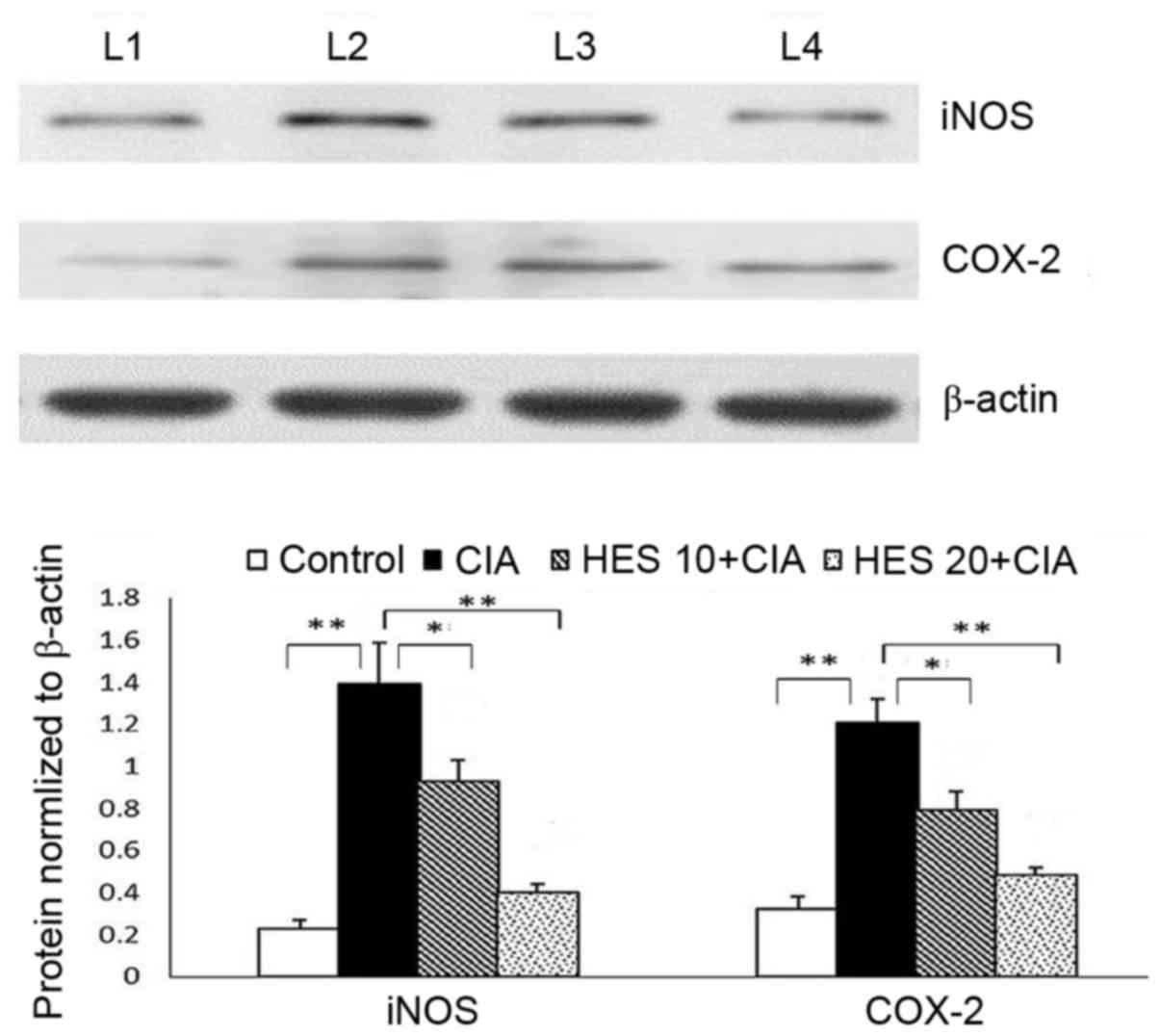Beneficial effect of 20‑hydroxyecdysone exerted by modulating antioxidants and inflammatory cytokine levels in collagen‑induced arthritis: A model for rheumatoid arthritis
- Authors:
- Published online on: August 29, 2017 https://doi.org/10.3892/mmr.2017.7389
- Pages: 6162-6169
Abstract
Introduction
Rheumatoid arthritis (RA) is a systemic autoimmune disease characterized by an elevated synovial inflammatory response with hyperplasia and subsequent destruction or erosion of cartilage, articular tissue and bone in major joints (1). Epidemiological studies have indicated that the incidence of RA in developing and developed countries has been increasing, and almost 0.5–1 in 100 individuals are annually diagnosed with RA worldwide (2). RA predominantly affects the elderly, and there is an increased prevalence in women due to the involvement of hormonal factors (3). RA is associated with a negative impact on quality of life due to severe pain, disability, and deformity, in addition to an association with cardiovascular and cerebrovascular diseases; therefore, it representsa large global socioeconomic burden (4).
The pathophysiology of RA is complex, although inflammation and oxidative stress are the principal contributors (5). Previous studies have suggested that inflammatory processes may be elevated during RA, which may elicit respiratory bursts to produce excessive free radicals, subsequently resulting in oxidative stress (imbalance between free radicals and antioxidants), which further intensifies synovial damage (6,7). At present, a number of types of drugs are prescribed to manage RA, including non-steroidal anti-inflammatory drugs (NSAIDs) and disease modifying anti-rheumatic drugs (DMARDs); however, these exhibit limited efficacy and are associated with numerous adverse events, including cardiovascular disease, gastrointestinal disorders, and hepatic and renal dysfunction (8,9). Therefore, research into novel phytomedicines or natural medicines for RA is increasing, due to the decreased risk of adverse events. A natural drug with effective anti-inflammatory and antioxidant activity may be a better option for the treatment of RA (10).
20-Hydroxyecdysone (HES), is a polyhydroxylated steroid hormone produced in insects and plants, including Ajuga reptans, Vitex negundo, Polypodium vulgare and Achyranthes japonica (11). HES serves a role in insect development, metabolism and reproduction by regulating the expression of various genes (12). In addition, it protects plants against insect and nematode infection. HES exhibits a broad range of biological properties in various models (in vitro and in vivo), including antioxidant, anti-inflammatory, immunomodulatory, anti-obesity and antidiabetic activities, in addition to acting as a neuroprotective and hepatoprotective agent (13–15). HES has been used as a dietary or nutritional supplement, particularly by body builders, due to its hormonal influences (16). HES it has been reported to be an anti-osteoporotic agent in ovariectomized rats (17,18). According to recent searches in academic databases and medical search engines (Google, www.google.com; PubMed, www.ncbi.nlm.nih.gov/pubmed; and Medline, www.medline.com), no studies have been conducted to assess the anti-RA activity of HES. Therefore, the present study aimed to evaluate the anti-RA activity of HES by measuring paw swelling (edema), arthritis score, index of spleen and thymus, antioxidant status and a number of inflammatory markers, in addition to histological analysis of synovial joint tissue, in the collagen-induced arthritis (CIA) rat model.
Materials and methods
Chemicals
HES, complete Freund's adjuvant (CFA), bovine type II collagen (CII) and formalin were purchased from Sigma-Aldrich (Merck KGaA, Darmstadt, Germany). Glycerol, NaOH, PBS, EDTA, hematoxylin and eosin (H&E) stains and H2O2 were obtained from Kangchen Bio-tech, Inc. (Shanghai, China). Other reagents and chemicals used in the present study were of analytical grade.
Experimental animals
A total of 40 healthy male Sprague-Dawley (SD) strain rats weighing 240–250 g were purchased from local pet animal dealer (Animal Aid, Heilongjiang, China) and housed in an animal center at Harbin Medical University, China. Rats were kept in a cage and maintainedunder standard housing conditions (12-h light/dark cycle at 23–24°C with 78% humidity) with food and water ad libitum. The use of animals in the present study was approved by the Ethical Committee Board of Harbin Medical University (no. HMU-34051) and all the experimental procedures and handling of animals were performed according to the guidelines laid out by the National Institutes of Health (Bethesda, MD, USA).
CIA induction (immunization)
CIA induction was performedusing the method of Liu et al (19). CII was combined with 0.05 M acetic acid and emulsified by adding equal amounts of CFA (with heat-inactivated Mycobacterium tuberculosis H37Ra) to make a CFA mixture/emulsion. The rats were induced/immunized with the CFA mixture via intradermal injection into the base of the tail on day 0, and a booster on the day 21 with CII and incomplete Freund's adjuvant (IFA; Sigma-Aldrich; Merck KGaA). Control rats were not administered with CFA mixture (non-immunized).
Experimental design
A total of 40 healthy male SD rats were selected arbitrarily and separated into four groups, with n=10 rats in each group. Rats receiving saline for 28 days without CIA induction served as control rats or the non-arthritic group (group I); rats subjected to CIA induction (as described above) served as the induced or CIA group (group II); and rats induced with CIA and administered with 10 or 20 mg/kg body-weight HES dissolved in saline, via intraperitoneal injection for 28 days, served as the treatment groups, or HES 10/20 + CIA (groups III and IV). On the initial day (day 0, without CIA induction), the days 14 and 28, the paw swelling (edema) volume was evaluated using a digital plethysmometer. The severity of arthritis was measured in the form of an arthritis score using the method of Zhang et al (20). Paws (hind- and fore-) were graded or scored by checking swelling and erythema using a five-point scale, assigned according to the extent of swelling or erythema as follows: 0, no sign of swelling or erythema (without any abnormal condition); 1, signs of swelling or erythema in ankle or wrist; 2, signs of swelling or erythema in the ankle + tarsal or wrist + carpal; 3, signs of swelling or erythema extended to the metatarsals or metacarpals; and 4, signs of swelling or erythema involving the entire hind-or forepaw. Therefore, each rat was able to attain a maximum score of 8 (4×2 hind-/forepaw). In addition, the body weight of each rat was monitored throughout the study.
Sample preparation
At the end of the experimental period (on the day 29) all rats were sacrificed by cervical decapitation, blood samples were collected and the serum was separated and centrifuged at 3,000 × g for 10 min at 4°C. The spleen and thymus glands were excised immediately and cleaned with saline, and the dry weights were noted. Synovial joint tissue was obtained from each rat and fixed in 10% formalin for histological analysis. A portion of joint tissue (10%) was homogenized using ice-cold PBS and used for biochemical and molecular analysis. The protein levels were measured using a Pierce bicinchoninic acid protein assay kit (Thermo Fisher Scientific, Inc., Waltham, MA, USA).
Thymus and spleen index assay, lipid peroxidation products and antioxidant enzymes
The thymus and spleen indexes were assayed using the method of Zhang et al (20) and were expressed as the ratio of mg/g. Lipid peroxidation products, including malondialdehyde (MDA) levels, were assessed in joint tissue using a commercial kit provided by Shanghai Yantuo Biotechnology Ltd. (Shanghai, China), according to the manufacturer's protocol. Similarly, catalase (CAT), superoxide dismutase (SOD), and glutathione (GSH) activity was assayed in joint tissue homogenate using commercial kits (Nanjing Jiancheng Bioengineering Institute, Nanjing, China) according to the manufacturer's protocol.
Histomorphological evaluation
Synovial joint tissue wasisolated from each rat and fixed in 10% buffered formalin (formaldehyde) for 24 h at 37°C and decalcified using EDTA. The tissues were embedded in liquid paraffin wax for sectioning by preparing tissue slices of 5-µm diameter using a microtome, and mounted onto a microscopic slide followed by staining with H&E for 10 h at 37°C. Subsequently, the joint tissue was examined under a light microscope from Olympus Corporation (Tokyo, Japan) to examine any histopathological changes.
Articular elastase and nitric oxide
Articular elastase (ELA) activity in articular joint tissues was assessed as the index of polymorphonuclear cell (PMN) accumulation (infiltration or activated inflammation) as described elsewhere by Umar et al (6). ELA was expressed as ng/g protein (based on the protein content of articular tissue). In the case of nitric oxide (NO) measurement, the Griess method was used following the protocols of Sun et al (21).
Anti-collagen II-specific immunoglobulins (Igs) and inflammatory markers
The levels of serum anti-collagen II IgG, IgG1, and IgG2a were measured as arbitrary units using ELISA kits (180128, 180124 and 180125 respectively; Thermo Fisher Scientific, Inc.). The concentrations of inflammatory markers, including C-reactive protein (CRP), cytokines [interleukins (IL-1β, IL-6), tumor necrosis factor (TNF)-α and cyclooxygenase-2 (COX-2)] in serum samples, and nuclear factor (NF)-κB p65 subunit from the joint tissue lysate [nuclear fraction isolated using Nuclear/Cytosolic Fractionation kit (AKR171; Cell Biolabs Inc., San Diego, CA, USA)], were evaluated using commercially available ELISA kits (KA1035, KA1502, KA1503, NBP1-92681, IMK503 respectively; Imgenex; Novus Biologicals, LLC, Littleton, CO, USA), according to the manufacturer's protocol.
Western blotting
Immunoblotting techniques were used to quantify the protein expression of inflammatory markers. The protein were extracted and estimated using a Pierce bicinchoninic acid protein assay kit (Thermo Fisher Scientific, Inc., Waltham, MA, USA). A protein extract of 50 µg (from each rat) was resolved using SDS-PAGE on a 12% gel, and electrotransferred onto a polyvinylidene difluoride membrane. The membrane was blocked with a mixture of 5% skimmed milk and Tween-20 in Tris-phosphate buffer solution (TPBS) for 1 h at 37°C, and incubated with the primary antibodies, mouse monoclonal anti-inducible nitric oxide synthase (iNOS; 2982) and anti-cycloxygenase-2 (COX-2; 4842; both 1:1,200; Cell Signaling Technology, Inc., Danvers, MA, USA) and β-actin (2791; 1:800; Beijing Zhongshan Jinqiao Biotechnology Co., Ltd.) for 10 h at 37°C. Aliquots of secondary antibody conjugated with anti-rabbit horseradish peroxidase (7074; 1:2,000; Cell Signaling Technology, Inc.) in TPBS were subsequently added and incubated at 37°C for 1 h. The formed protein bandswere visualized using an enhanced chemiluminescent image analyzer (ChemiDoc-17001401; Bio-Rad Laboratories, Inc., Hercules, CA, USA), and the specific proteins were quantified using ImageJ software version 5.1 (National Institutes of Health, Bethesda, MD, USA).
Statistical analysis
Experiments were performed in triplicate. The data values were expressed as the mean ± standard deviation. The significant differences between each group were assessed using one-way analysis of variance followed by Tukey's post hoc test for multiple comparisons. SPSS software version 21 (IBM Corp., Armonk, NY, USA) was used for the analysis. P<0.05 was considered to indicate a statistically significant difference.
Results
Paw swelling and arthritis scores
The effect of HES on the levels of paw swelling (edema) and arthritis scores in experimental rats are presented in Figs. 1 and 2. On days 14 and 28, the paw swelling (edema) and arthritis scores (swelling and erythema) of CIA-induced rats were significantly increased (P<0.01) compared with the control rats. By contrast, supplementation with doses of HES (10 and 20 mg/kg) significantly decreased (P<0.01) the edema and the signs and symptoms of arthritis (swelling and erythema) compared with the CIA-induced rats.
Thymus and spleen index (weight) assay
Fig. 3 illustrates the effect of HES on the index of the thymus (Fig. 3A) and spleen (Fig. 3B) in experimental rats. Compared with control rats, a significant increase (P<0.01) in the thymus and spleen indexes was observed in the CIA group. By contrast, HES supplementation significantly (P<0.01) suppressed the thymus and spleen index compared with the CIA-induced rats.
Joint tissue antioxidants and lipid peroxidation products
Table I summarizes the effect of HES on the activities of joint tissue lipid peroxidation products (MDA) and antioxidants in experimental rats. The levels of joint tissue MDA were significantly increased (P<0.01), with a significant decrease (P<0.01) in the activities of joint tissue antioxidants CAT, SOD and GSH in the CIA group. However, treatment with HES at 10 and 20 mg/kg reverted the MDA levels to near-normalcy and ameliorated the activities of CAT, SOD and GSH compared with the CIA-immunized rats.
Table I.Effect of HES on the activities of joint tissue lipid peroxidation products and antioxidants in experimental rats. |
Joint tissue morphology
The effect of HES on the joint tissue sections stained with H & E (magnification, ×200) in experimental rats are presented in Fig. 4. The normal architecture of articular cartilage without any mononuclear or PMN cell infiltration was observed in control rats (Fig. 4A). The CIA-induced rats (Fig. 4B) exhibited increased PMN infiltration with eroded articular cartilage and prominent synovitis, which are indicated by arrows. Rats treated with 10 mg/kg HES (Fig. 4C) displayed decreased PMN infiltration with reduced cartilage erosion and synovitis. Rats treated with 20 mg/kg HES (Fig. 4D) exhibited healthy articular cartilage, with limited PMN infiltration and synovitis.
Joint tissue ELA activity
Fig. 5 demonstrates the effect of HES on joint tissue ELA activity in experimental rats. The rats induced with CIA displayed a significant increase (P<0.01) in the activity of ELA compared with non-immunized rats (control). HES dosages of 10 (P<0.01) and 20 mg/kg (P<0.01) in CIA-induced rats significantly decreased the activity of ELA compared with the CIA group.
Levels of anti-collagen II-specific Igs
IgG, IgG1, and IgG2a levels were significantly increased (P<0.01) in CIA-induced rats compared with control rats (Fig. 6). Doses of 10 and 20 mg/kg HES reversed the elevated collagen-specific Ig levels almost to those of the control group.
Inflammatory markers
Table II presents the effect of HES on the concentration of the inflammatory markers, NO, COX-2 and CRP, in experimental rats. A significant elevation (P<0.01) in the levels of NO, COX-2 and CRP was noted in the CIA group compared with control rats. Therapy with 10 and 20 mg/kg HES decreased the levels of NO, COX-2 and CRP compared with the CIA rats. Table III exhibits the effect of HES on the concentration of pro-inflammatory cytokines in experimental rats. The concentrations of IL-1β, IL-6, TNF-α (all serum) and NF-κB p65 subunit (joint tissue) were significantly increased (P<0.01) in CIA rats. However, treatment with HES (10 and 20 mg/kg) decreased the concentration of IL-1β, IL-6, TNF-α and NF-κB p65 subunit compared with CIA rats.
Protein expression of iNOS and COX-2
Fig. 7 illustrates the effect of HES on the protein expression of iNOS and COX-2 inthe joint tissue ofexperimental rats, as determined by immunoblotting. In the CIA-induced group, the expression of iNOS and COX-2 protein in the joint tissues was significantly upregulated (P<0.01). Following 28 days of treatment with HES, the protein expression was significantly downregulated (P<0.01). The twodosages of HES exhibited anti-RA effects, although HES 20 exhibited increased efficacy in all of the above discussed parameters.
Discussion
A number of studies have suggested that the use of synthetic or semi-synthetic anti-RA drugs, including NSAIDs and DMARDs, may lead to severe side effects (8,9). Therefore, the use of natural drugs may be the better option, due to the decreased risk of adverse events and the possibility of the identification of effective anti-RA agents. Previous studies have indicated that polyphenols, terpenoids and steroids (also termed nutraceuticals) from plants may decrease oxidative stress and inflammatory responses, and thus act as anti-RA agents (22,23). Therefore, in the present study, the phytosterol (ecdysteroid) HES was used to assess anti-RAproperties. The CIA-induced animal model was employed for the present study, as CIA may alter cellular and humoral immunity and thus mimic the human RA condition. Previous studies have demonstrated that attenuation of the CIA-induced inflammatory process in rats is among the best methods to assess the anti-RA activity of a drug (24,25).
Paw swelling (edema) and arthritis scores are the most important factors to consider when examining the anti-inflammatory and anti-arthritic properties of a drug (26). The paw swelling and arthritis scores (swelling and erythema) of the CIA-induced rats in the present study were markedly increased. Treatment with HES decreased the paw swelling and symptoms of arthritis compared with CIA-induced rats. Previously, Achyranthes aspera, which is rich in HES, has been observed to inhibit paw swelling in the CIA-induced animal model, thus further demonstrating its anti-arthritic activity (27).
The spleen and thymus are the major lymphoid organs that regulate the immune system, and their relative weight (index) indicates their functional properties. Therefore, the indexes of the thymus and spleen were used in the present study to evaluate immunoregulatory activity as, during RA, immune organ indexes have been observed to be altered (28). A marked increase in the indexes of the thymus and spleen was observed in CIA rats; however, with the addition of HES, those indexes were suppressed, demonstrating the immune modulatory activity of HES. Consistently, previous studies have suggested that HES may act as an immune modulatory agent in the diet-induced obesity mouse model (15,29).
Previous experimental studies have demonstrated that inflammatory processes are markedly increased during RA, which may stimulate respiratory bursts to produce excessive free radicals, and subsequently result in oxidative stress and intensified synovial damage (6,7). Oxidative stress and inflammation are associated with each other and may interact to directly contribute to the pathophysiology of RA (1). The levels of joint tissue MDA were observed to be increased in the present study, with a decline in the activities of the joint tissue antioxidants, CAT, SOD, and GSH, indicating the presence of oxidative stress. However, treatment with 10 and 20 mg/kg HES significantly suppressed the MDA levels and restored the activities of CAT, SOD and GSH, nearly to the levels in sham-control rats. The results of the present study are consistent with the results of Sundaram et al (30), who demonstrated that supplementation with HES was able to increase the activities of antioxidants, including SOD, CAT and GSH, with reduced lipid peroxidation products in a diabetic rat model.
In order to ascertain the severity of arthritis in CIA-induced rats and HES-treated rats, histological alterations to the joint tissue were observed to validate the results of the biochemical studies. The control rat joint exhibited normal architecture with an absence of mononuclear or PMN cell infiltration. Increased PMN infiltration with eroded articular cartilage, in addition to prominent synovitis, were noted in CIA rats. Slides from rats treated with 10 mg/kg HES exhibited decreased PMN infiltration with reduced cartilage erosion and synovitis. However, the 20 mg/kg HES group displayed fewer histological alterations with normal articular cartilage, although limited PMN infiltration and synovitis were observed. Similarly, administration of HES has been demonstrated to exert a beneficial effect on cartilage/bone in the joints by decreasing inflammation and subsequently reducing cartilage or trabecular bone erosion in ovariectomized rats (18).
As described above, the activity of ELA (a serine proteinase) in joint tissue was assessed in the present study as the index of PMN accumulation (infiltration or activated inflammation). Activated PMNs are the most significant contributor to free radical generation (reactive oxygen/nitrogen species), particularly in joint tissue (31). The CIA-induced animals exhibited increased ELA activity, whereas treatment with HES significantly decreased the activity of ELA, demonstrating its antioxidant and anti-inflammatory activity (32). The results of the present study suggested that treatment with HES inhibited the infiltration of leukocytes, and thereby dampened the inflammatory response.
A previous study suggested that the production of anti-collagen IIIgG, IgG1 and IgG2awas elevated in the CIA-induced animal model (33). Similarly, during CIA induction in the present study, IgG, IgG1and IgG2a levels were observed to be increased. HES supplementation reversed the elevated levels of the collagen-specific Igs to normalcy. It may be hypothesized that improved spleen and thymus indexes following treatment with HES may be associated with its immune regulatory activity. Kizelsztein et al (29) observed that HES supplementation may alter the immune system and therebymodulatethe production of different antibodies in mouse models.
NO is a signaling or messenger molecule that is produced from L-arginine, catalyzed by NOS enzymes. During RA (with activated PMNs), iNOS is upregulated, leading to an abundance of NO and contributing to further inflammatory responses due to its conversion to peroxynitrite and subsequent damage to cartilage (34,35). Prostaglandins are important lipid mediators, which are highly expressed in synovial joints in RA through upregulation of the inducible isoform of COX-2 (36). Plant et al (37) demonstrated that CRP is an important inflammatory mediator in RA which is secreted during infection or altered immunological conditions, with levels increasing in the liver and, therefore, in the serum. Therefore, evaluating inflammatory markers, including NO, COX-2 and CRP, may demonstrate whether HES is able to effectively act as an anti-rheumatoid agent in the CIA-induced rat model. In the present study, the levels of NO, COX-2 and CRP were increased in the CIA group compared with control rats. A significant decrease in the levels of NO, COX-2, and CRP was observed in HES-treated rats. HES has been reported to be an anti-inflammatory agent, due to its inactivation of NF-κB and subsequent inhibition of the secretion of CRP, in addition to the expression of inflammatory enzymes, including iNOS and COX-2 (16,38).
The pro-inflammatory cytokines TNF-α, IL-1β and IL-6, and NF-κB p65, have been observed to be markedly upregulated in synovial joints, and serve a role in the physiopathology of RA by evoking an inflammatory response (39,40). The concentrations of IL-1β, IL-6, TNF-α and NF-κΒp65 were significantly increased in CIA rats in the present study. During the CIA-induced/RA condition, PMNs are activated, and promote the expression of major histocompatibility complex class II molecules in inflamed joint tissues, thereby producing free radicals and pro-inflammatory cytokines by triggering the NF-κB signaling pathway (41). The pro-inflammatory cytokines assayed in the present study were markedly downregulated following treatment with HES. Xia et al (42), demonstrated that supplementation with HES attenuated the production of pro-inflammatory cytokines in a streptozotocin-induced rat model.
In order to examine the mechanism underlying the anti-rheumatoid and anti-inflammatory activity of HES, the present study quantified the protein expression of various inflammatory enzymes, including iNOS and COX-2. The gene expression of iNOS and COX-2 is regulated by the pro-inflammatory cytokines that are activated by TNF-α and the NF-κB pathway (28). Jia et al (35) indicated that inhibition of the COX-2 and iNOS signaling pathways may promote anti-RA activity in the CIA-induced rat model (35). The protein expression of iNOS and COX-2 in the joint tissues of CIA-induced animals were upregulated in the present study. The elevated levels of pro-inflammatory cytokines in CIA rats further stimulate the production of chemokines and chemotactic molecules and upregulate the expression of inflammatory enzymes, including iNOS and COX-2. However, 28 days of treatment with 10 and 20 mg/kg HES downregulated the protein expression of iNOS and COX-2 compared with the CIA rats, thereby further demonstrating the anti-inflammatory activity of HES. The western blotting results of the present study are consistent with the results of the assay of NO and COX-2 activity in the serum. Hu et al (32) observed that treatment with HES may effectively downregulate the expression of iNOS, and thereby hamper the production of NO (32). It may be hypothesized that HES markedly inhibited NF-κB activation by hampering the translocation of the NF-κΒp65 subunit from the cytosol into the nucleus. Therefore HES (particularly at a concentration of 20 mg/kg) may inactivate the NF-κB signaling pathway and downregulate the expression of inflammation-associated genes, particularly pro-inflammatory cytokines (IL-1β, IL-6 and TNF-α) and inflammatory enzymes, including iNOS and COX-2. The present study exhibits certain limitations, however, including a lack of investigation into the underlying mechanism behind the association between HES and any specific signaling pathways, in addition to not utilizing a standard, for example, dexamethasone or methotrexate, to compare with the anti-RA activity of HES.
In conclusion, the results of the present study indicated that treatment with HES (particularly 20 mg/kg) may protect the joint tissue against excessive production of free radicals by augmenting endogenous antioxidant levels, and may thereby maintain the integrity of synovial joint tissue or cartilage by decreasing paw edema/swelling, arthritis score, ELA activity and auto-antibodies, in addition to inhibiting the activation of PMNs. Treatment with HES inhibited the NF-κB signaling pathway and its inflammation-associated genes, particularly inflammatory markers (NO, COX-2 and CRP), pro-inflammatory cytokines (IL-1β, IL-6 and TNF-α), and the inflammatory enzymes iNOS and COX-2. Future studies will evaluate the underlying mechanism of the anti-RA and anti-inflammatory activities of HES in different models.
Acknowledgements
The present study was funded by the National Natural Science Fund Project (grant no. 81202339) and Educating General Projects of Heilongjiang Province (grant no. 11511238).
References
|
Umar S, Umar K, Sarwar AH, Khan A, Ahmad N, Ahmad S, Katiyar CK, Husain SA and Khan HA: Boswellia serrata extract attenuates inflammatory mediators and oxidative stress in collagen induced arthritis. Phytomedicine. 21:847–856. 2014. View Article : Google Scholar : PubMed/NCBI | |
|
Alamanos Y and Drosos AA: Epidemiology of adult rheumatoid arthritis. Autoimmun Rev. 4:130–136. 2005. View Article : Google Scholar : PubMed/NCBI | |
|
Symmons D, Turner G, Webb R, Asten P, Barrett E, Lunt M, Scott D and Silman A: The prevalence of rheumatoid arthritis in the United Kingdom: New estimates for a new century. Rheumatology (Oxford). 41:793–800. 2002. View Article : Google Scholar : PubMed/NCBI | |
|
Jacobs P, Bissonnette R and Guenther LC: Socioeconomic burden of immune-mediated inflammatory diseases - focusing on work productivity and disability. J Rheumatol Suppl. 88:55–61. 2011. View Article : Google Scholar : PubMed/NCBI | |
|
Umar S, Sarwar AH Golam, Umar K, Ahmad N, Sajad M, Ahmad S, Katiyar CK and Khan HA: Piperine ameliorates oxidative stress, inflammation and histological outcome in collagen induced arthritis. Cell Immunol. 284:51–59. 2013. View Article : Google Scholar : PubMed/NCBI | |
|
Umar S, Zargan J, Umar K, Ahmad S, Katiyar CK and Khan HA: Modulation of the oxidative stress and inflammatory cytokine response by thymoquinone in the collagen induced arthritis in Wistar rats. Chem Biol Interact. 197:40–46. 2012. View Article : Google Scholar : PubMed/NCBI | |
|
Mateen S, Moin S, Khan AQ, Zafar A and Fatima N: Increased reactive oxygen species formation and oxidative stress in rheumatoid arthritis. PLoS One. 11:e01529252016. View Article : Google Scholar : PubMed/NCBI | |
|
Negrei C, Bojinca V, Balanescu A, Bojinca M, Baconi D, Spandidos DA, Tsatsakis AM and Stan M: Management of rheumatoid arthritis: Impact and risks of various therapeutic approaches. Exp Ther Med. 11:1177–1183. 2016. View Article : Google Scholar : PubMed/NCBI | |
|
Singh JA, Saag KG, Bridges SL Jr, Akl EA, Bannuru RR, Sullivan MC, Vaysbrot E, McNaughton C, Osani M, Shmerling RH, et al: 2015 American college of rheumatology guideline for the treatment of rheumatoid arthritis. Arthritis Rheumatol. 68:1–26. 2016. View Article : Google Scholar : PubMed/NCBI | |
|
Adhikary R, Majhi A, Mahanti S and Bishayi B: Protective effects of methanolic extract of Adhatoda vasica Nees leaf in collagen-induced arthritis by modulation of synovial toll-like receptor-2 expression and release of pro-inflammatory mediators. J Nutr Intermed Metab. 3:1–11. 2016. View Article : Google Scholar | |
|
Boo KH, Lee D, Jeon GL, Ko SH, Cho SK, Kim JH, Park SP, Hong Q, Lee SH, Lee DS and Riu KZ: Distribution and biosynthesis of 20-hydroxyecdysone in plants of Achyranthes japonica Nakai. Biosci Biotechnol Biochem. 74:2226–2231. 2010. View Article : Google Scholar : PubMed/NCBI | |
|
Tarrant AM, Reitzel AM, Blomquist CH, Haller F, Tokarz J and Adamski J: Steroid metabolism in cnidarians: Insights from Nematostella vectensis. Mol Cell Endocrinol. 301:27–36. 2009. View Article : Google Scholar : PubMed/NCBI | |
|
Kumpun S, Girault JP, Dinan L, Blais C, Maria A, Dauphin-Villemant C, Yingyongnarongkul B, Suksamrarn A and Lafont R: The metabolism of 20-hydroxyecdysone in mice: Relevance to pharmacological effects and gene switch applications of ecdysteroids. J Steroid Biochem Mol Biol. 126:1–9. 2011. View Article : Google Scholar : PubMed/NCBI | |
|
Xia XC, Gui GX, Li YF, Hua CX, Liu JH and Li HW: Anti-oxidative ability study of 20-hydroxyecdysone on acute liver injury of mice. J Liaoning Univ Tradit Chin Med. 10:81–83. 2012. | |
|
Foucault AS, Even P, Lafont R, Dioh W, Veillet S, Tomé D, Huneau JF, Hermier D and Quignard-Boulangé A: Quinoa extract enriched in 20-hydroxyecdysone affects energy homeostasis and intestinal fat absorption in mice fed a high-fat diet. Physiol Behav. 128:226–231. 2014. View Article : Google Scholar : PubMed/NCBI | |
|
Lafont R and Dinan L: Practical uses for ecdysteroids in mammals including humans: An update. J Insect Sci. 3:72003. View Article : Google Scholar : PubMed/NCBI | |
|
Seidlova-Wuttke D, Christel D, Kapur P, Nguyen BT, Jarry H and Wuttke W: Beta-ecdysone has bone protective but no estrogenic effects in ovariectomized rats. Phytomedicine. 17:884–889. 2010. View Article : Google Scholar : PubMed/NCBI | |
|
Kapur P, Wuttke W, Jarry H and Seidlova-Wuttke D: Beneficial effects of beta-Ecdysone on the joint, epiphyseal cartilage tissue and trabecular bone in ovariectomized rats. Phytomedicine. 17:350–355. 2010. View Article : Google Scholar : PubMed/NCBI | |
|
Liu Q, Zhu XZ, Feng RB, Liu Z, Wang GY, Guan XF, Ou GM, Li YL, Wang Y, Li MM and Ye WC: Crude triterpenoid saponins from Anemone flaccida (Di Wu) exert anti-arthritic effects on type II collagen-induced arthritis in rats. Chin Med. 10:202015. View Article : Google Scholar : PubMed/NCBI | |
|
Zhang LL, Wei W, Yan SX, Hu XY and Sun WY: Therapeutic effects of glucosides of Cheanomeles speciosa on collagen-induced arthritis in mice. Acta Pharmacol Sin. 25:1495–1501. 2004.PubMed/NCBI | |
|
Sun J, Zhang X, Broderick M and Fein H: Measurement of nitric oxide production in biological systems by using Griess reaction assay. Sensors. 3:276–284. 2003. View Article : Google Scholar | |
|
Khanna D, Sethi G, Ahn KS, Pandey MK, Kunnumakkara AB, Sung B, Aggarwal A and Aggarwal BB: Natural products as a gold mine for arthritis treatment. Curr Opin Pharmacol. 7:344–351. 2007. View Article : Google Scholar : PubMed/NCBI | |
|
Al-Okbi SY: Nutraceuticals of anti-inflammatory activity as complementary therapy for rheumatoid arthritis. Toxicol Ind Health. 30:738–749. 2014. View Article : Google Scholar : PubMed/NCBI | |
|
Kargutkar S and Brijesh S: Anti-rheumatic activity of Ananas comosus fruit peel extract in a complete Freund's adjuvant rat model. Pharm Biol. 54:2616–2622. 2016. View Article : Google Scholar : PubMed/NCBI | |
|
Talaat RM, Abo-El-Atta AS, Farou SM and El-Dosoky KI: Therapeutic effect of dimethyl dimethoxy biphenyl dicarboxylate on collagen-induced arthritis in rats. Chin J Integr Med. 21:846–854. 2015. View Article : Google Scholar : PubMed/NCBI | |
|
Petchi RR and Vijaya C: Anti-diabetic and anti-arthritic potential of Glycosmis pentaphylla stem bark in FCA induced arthritis and streptozotocin induced diabetic rats. Pharmacol Int J Pharma Biol Sci. 3:328–336. 2012. | |
|
Srivastav S, Singh P, Mishra G, Jha KK and Khosa RL: Achyranthes aspera-An important medicinal plant: A review. J Nat Prod Plant Resour. 1:1–4. 2011. | |
|
Jiang CP, He X, Yang XL, Zhang SL, Li H, Song ZJ, Zhang CF, Yang ZL, Li P, Wang CZ and Yuan CS: Anti-rheumatoid arthritic activity of flavonoids from Daphne genkwa. Phytomedicine. 21:830–837. 2014. View Article : Google Scholar : PubMed/NCBI | |
|
Kizelsztein P, Govorko D, Komarnytsky S, Evans A, Wang Z, Cefalu WT and Raskin I: 20-Hydroxyecdysone decreases weight and hyperglycemia in a diet-induced obesity mice model. Am J Physiol Endocrinol Metab. 296:E433–E439. 2009. View Article : Google Scholar : PubMed/NCBI | |
|
Sundaram R, Naresh R, Shanthi P and Sachdanandam P: Ameliorative effect of 20-OH ecdysone on streptozotocin induced oxidative stress and β-cell damage in experimental hyperglycemic rats. Process Biochem. 47:2072–2080. 2012. View Article : Google Scholar | |
|
Campo GM, Avenoso A, Campo S, Ferlazzo AM, Altavilla D and Calatroni A: Efficacy of treatment with glycosaminoglycans on experimental collagen-induced arthritis in rats. Arthritis Res Ther. 5:R122–R131. 2003. View Article : Google Scholar : PubMed/NCBI | |
|
Hu J, Luo CX, Chu WH, Shan YA, Qian ZM, Zhu G, Yu YB and Feng H: 20-Hydroxyecdysone protects against oxidative stress-induced neuronal injury by scavenging free radicals and modulating NF-κB and JNK pathways. PLoS One. 7:e507642012. View Article : Google Scholar : PubMed/NCBI | |
|
Choi JH, Lee JH, Roh KH, Seo SK, Choi IW, Park SG, Lim JG, Lee WJ, Kim MH, Cho KR and Kim YJ: Gallium nitrate ameliorates type II collagen-induced arthritis in mice. Int Immunopharmacol. 20:269–275. 2014. View Article : Google Scholar : PubMed/NCBI | |
|
Breitbach K, Klocke S, Tschernig T, van Rooijen N, Baumann U and Steinmetz I: Role of inducible nitric oxide synthase and NADPH oxidase in early control of Burkholderia pseudomallei infection in mice. Infect Immun. 74:6300–6309. 2006. View Article : Google Scholar : PubMed/NCBI | |
|
Jia N, Chu W, Li Y, Ding L, Duan J, Cui J, Cao S, Zhao C, Wu Y and Wen A: Iridoid glycosides from the flowers of Gentiana macrophylla Pall. ameliorate collagen-induced arthritis in rats. J Ethnopharmacol. 189:1–9. 2016. View Article : Google Scholar : PubMed/NCBI | |
|
Jia Z and He J: Paeoniflorin ameliorates rheumatoid arthritis in rat models through oxidative stress, inflammation and cyclooxygenase 2. Exp Ther Med. 11:655–659. 2016. View Article : Google Scholar : PubMed/NCBI | |
|
Plant MJ, Williams AL, O'Sullivan MM, Lewis PA, Coles EC and Jessop JD: Relationship between time-integrated C-reactive protein levels and radiologic progression in patients with rheumatoid arthritis. Arthritis Rheum. 43:1473–1477. 2000. View Article : Google Scholar : PubMed/NCBI | |
|
Feng CY, Huang XR and Qi MX: Effects of ecdysterone on the expression of NF-kappaB p65 in H2O2 induced oxidative damage of human lens epithelial cells. Zhongguo Zhong Xi Yi Jie He Za Zhi. 32:76–79. 2012.(In Chinese). PubMed/NCBI | |
|
Cooles FA and Isaacs JD: Pathophysiology of rheumatoid arthritis. Curr Opin Rheumatol. 23:233–240. 2011. View Article : Google Scholar : PubMed/NCBI | |
|
McInnes IB and Schett G: Cytokines in the pathogenesis of rheumatoid arthritis. Nat Rev Immunol. 7:429–442. 2007. View Article : Google Scholar : PubMed/NCBI | |
|
Cohen S, Hurd E, Cush J, Schiff M, Weinblatt ME, Moreland LW, Kremer J, Bear MB, Rich WJ and McCabe D: Treatment of rheumatoid arthritis with anakinra, a recombinant human interleukin-1 receptor antagonist, in combination with methotrexate: Results of a twenty-four-week, multicenter, randomized, double-blind, placebo-controlled trial. Arthritis Rheum. 46:614–624. 2002. View Article : Google Scholar : PubMed/NCBI | |
|
Xia X, Zhang Q, Liu R, Wang Z, Tang N, Liu F, Huang G, Jiang X, Gui G, Wang L and Sun X: Effects of 20-hydroxyecdysone on improving memory deficits in streptozotocin-induced type 1 diabetes mellitus in rat. Eur J Pharmacol. 740:45–52. 2014. View Article : Google Scholar : PubMed/NCBI |



